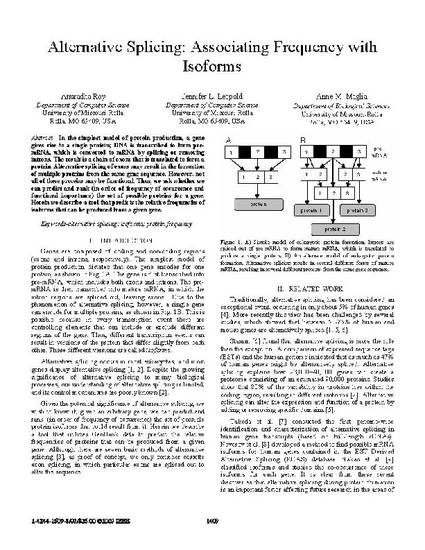
Article
Alternative Splicing: Associating Frequency with Isoforms
Proceedings of the IEEE 7th International Symposium on Bioinformatics and Bioengineering (2007, Boston, MA)
Abstract
In the simplest model of protein production, a gene gives rise to a single protein; DNA is transcribed to form pre-mRNA, which is converted to mRNA by splicing or removing introns. The result is a chain of exons that is translated to form a protein. Alternative splicing of exons may result in the formation of multiple proteins from the same gene sequence. However, not all of these proteins may be functional. Thus, we ask whether we can predict and rank (in order of frequency of occurrence and functional importance) the set of possible proteins for a gene. Herein we describe a tool that predicts the relative frequencies of isoforms that can be produced from a given gene.
Meeting Name
IEEE 7th International Symposium on Bioinformatics and Bioengineering (2007: Oct. 14-17, Boston, MA)
Department(s)
Computer Science
Second Department
Biological Sciences
Keywords and Phrases
- Alternative Splicing,
- Isoforms,
- Pre-MRNA,
- Protein Frequency
International Standard Book Number (ISBN)
978-1-4244-1509-0
Document Type
Article - Conference proceedings
Document Version
Final Version
File Type
text
Language(s)
English
Rights
© 2007 Institute of Electrical and Electronics Engineers (IEEE), All rights reserved.
Publication Date
10-17-2007
Publication Date
17 Oct 2007
Disciplines
Citation Information
Anuradha Roy, Jennifer Leopold and Anne M. Maglia. "Alternative Splicing: Associating Frequency with Isoforms" Proceedings of the IEEE 7th International Symposium on Bioinformatics and Bioengineering (2007, Boston, MA) (2007) p. 1409 - 1413 Available at: http://works.bepress.com/jennifer-leopold/16/
